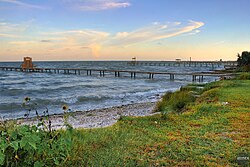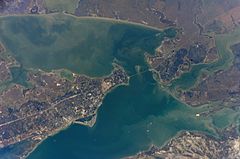Aransas Bay
| Aransas Bay | |
|---|---|

Piers near Fulton
|
|
 |
|
| Location | Texas Gulf Coast |
| Coordinates | 28°03′01″N 96°59′30″W / 28.05028°N 96.99167°W |
| Ocean/sea sources | Gulf of Mexico |
| Basin countries | United States |
Aransas Bay is a bay on the Texas gulf coast, approximately 30 miles (48 km) northeast of Corpus Christi, and 173 miles (278 km) south of San Antonio. It is separated from the Gulf of Mexico by San José Island (also referred to as St. Joseph Island). Aransas Pass is the most direct navigable outlet into the Gulf of Mexico from the bay. The cities of Aransas Pass and Port Aransas are located at the southern end, and Rockport is found on the central western shore. The bay is oriented laterally northeast-southwest, and is extended by Redfish Bay to the southwest, Copano Bay to the west, Saint Charles Bay to the north, and Mesquite Bay to the northeast. Aransas Bay is part of the Mission-Aransas National Estuarine Research Reserve.
There is a rich history of settlements on the bay, including: ancient Native American campgrounds dating back millennia; 19th-century European immigrant towns such as Lamar and Aransas; and the present day cities of Rockport, Fulton and Aransas Pass. Resources such as shrimp, fish, oysters and oil are found in or near the bay, and contribute to the local economies.
Humans first inhabited the area surrounding Aransas Bay approximately 6,000 to 8,000 years ago. The name derives from a group of indigenous people called the Aransas Indians, whose 4,000-year-old campsites have been found near the bay. The nomadic Aransas, left the area circa 1200 to 1300 CE. According to archeologists, the Karankawa and Coahuiltecan had coalesced as people and migrated into the area by 1400. They had severe losses and were much reduced by the 1800s due to new infectious diseases contracted from European explorers.Alonso Álvarez de Pineda of Spain is believed to be the first European to sail the bay, circa 1519. For over a century later, the Spanish had little interest in the area until the French established a colony in Texas in the late 17th century. At this time, Alonso De León was ordered to found a settlement in the area, but no permanent colony on the bay was ever established.
...
Wikipedia
